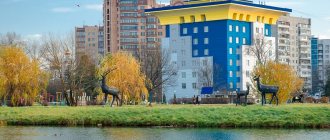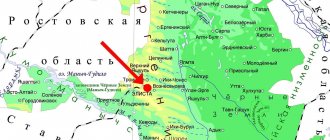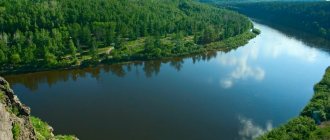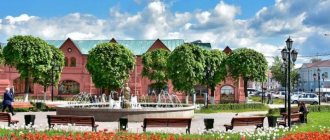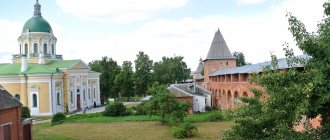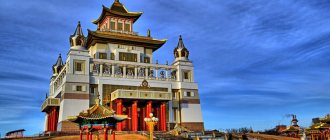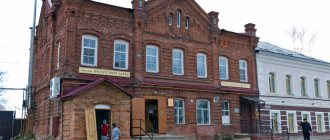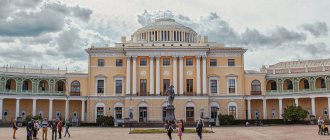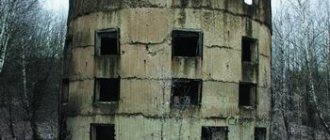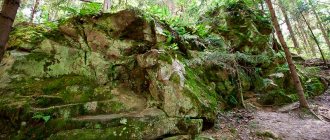The city with such a kind and sweet name is located on the shores of the Kama Reservoir Bay. The city is small, only about 36 thousand inhabitants, but with an interesting history. And the preserved flavor of the ancient Ural mining town, despite the fact that the ancient plant was hidden by the waves of the Kama Sea more than 60 years ago.
Where did this name come from - Dobryanka? An old legend tells about this, recorded back in the 19th century by P.I. Syuzev:
“It was a long time ago, when robbers still sailed along the Kama. So they had to land on the shore, divide their bellies from the loot, drink, eat, and have fun. They see a creek, they turn into it - quietly, freely, the mountains, and from the mountains the Kama, as if held in the hand. The ataman saw a place, and he ordered to build a house here, and in the house he put the girl Maryanka, so that she could live here, brew beer, cook all sorts of bread and concoctions, and receive and treat them, the robbers. So this house began to be called Maryanka’s house, after that the river began to be called Maryanka’s House, and then Dobryanka.”
And indeed, at the beginning of the 19th century they often said Domryanka, Domryansky plant, only by the middle of the century the name Dobryanka was firmly established. There is still no generally accepted scientific explanation for the origin of this name. It is only clear that the name of the river is primary.
City `s history
The city of Dobryanka (the original name was the village of Domryanka) arose in the 1st half of the 17th century - then it was just a peasant village of 19 houses.
The peasants lived by farming and fishing and at that time did not yet know that literally a hundred years later their small homeland would begin to turn into an industrial center of ferrous metallurgy.
In 1752, the construction of a copper smelter was launched in Dobryanka under the patronage of the Stroganov family, the famous salt workers of the Perm region.
They did not immediately become interested in metallurgy, since by that time they owned the entire “salt kingdom,” but the trends of the times were such that the country needed a lot of copper in the 18th century, and the Stroganovs supported the general trend.
It turned out, however, that there was not enough copper in the Dobryansk ores, and by the first half of the 19th century the plant was completely retrained as an iron-making plant. Later, where the city of Dobryanka is located (2 km away), the Sofia plant (named after the wife of S.G. Stroganov) grew up, which merged with the first one.
It produced sheet iron, metal for roofing and utensils, anchors, bricks and wire. The products of the Stroganov Ironworks were appreciated and widely used, first in the construction and then in the restoration of palaces and churches in Moscow and St. Petersburg (in particular, the Winter Imperial Palace).
Dobryanka was a classic Ural factory village with a constant population increase and its own culture: regular fairs were held, an amateur theater operated, and even had its own orchestra.
In 1918, a year after the establishment of Soviet power, the plant was nationalized, and in 1923 it was mothballed: there was turmoil in the country, practically nothing was being built, there was no demand for raw materials and products. The plant was relaunched in 1925, when the country's economy headed towards industrialization.
During the war years, the Dobryansk Metallurgical Plant produced armored sheets and shell casings.
More than 6,000 Dobryanka residents (mostly men) went to the front, many did not return, which negatively affected the population. Mostly women and children remained to work at the plant.
Despite difficult times, in 1943 the Dobryansky open-hearth shop was awarded the award as the best steelmaking shop in the Soviet Union, and Dobryanka from the urban-type settlement became a city. After this, the plant did not exist for long: already in the early 1950s it became known that the construction of the Kama Hydroelectric Power Station would require flooding the lowland of the Kama Sea (reservoir) and the territory of the plant would be under water.
Officially, on January 17, 1956, the plant ceased to exist, but by that time another large-scale enterprise was already operating in the city - the RMZ (mechanical repair plant), where trucks and tractors from all over the country were brought for repair and maintenance.
During the second half of the 20th century the following were built:
- a house-building plant engaged in timber processing (1956);
- oil wells (the center of oil production was in the village of Polazna, 1949);
- a thermal power plant that provided jobs for thousands of local people and visiting power engineers from different parts of Russia (1976);
- Perm State District Power Plant (1986).
The population of Dobryanka is just over 32,000 people (compared to 6,000 at the beginning of the century). Today the city is a center for the electric power, oil and logging industries.
Statistics by year
If we consider how the population of the Perm Territory has changed, here are the figures given by Rosstat of the Russian Federation:
- In 1939 - 2,087,518 people.
- In 1959 – 2,992,876.
- In 1970 – 3,023,443.
- In 1987, the population stopped arriving at the same rate as before, so the number of people during this period, even for a number of objective reasons, decreased and amounted to only 3,011,540 citizens.
- By 1990, the number of people living in this territory was 3,027,958.
- By 1996, the recession continued to accelerate, leading to even greater declines. The number of people here has dropped to 2,943,491.
- And this trend continued until 2012. By this period, the number of people in the region was 2,631,073.
- From that moment on, the dynamics changed somewhat in a positive direction. And, although the increase did not increase too quickly, it was still present. Therefore, by 2015, 2,637,032 began to live here.
- But this is where the growth stopped, since until 2022 the trend toward population decline resumed again. For the current calendar period, the number of Russians populating this territory is 2,599,260 people.
Coat of arms and anthem
Initially, the coat of arms of Dobryanka was developed back in the Soviet era. It had a schematic image of the Perm State District Power Plant, the contours of a spruce tree, a circular saw and a high-voltage transmission line, but a different coat of arms was adopted in 1997.
The new shield depicted a golden chapel, it was topped with a silver crown, and behind it were two golden hammers, connected by a red ribbon, crosswise.
In 2006, a new coat of arms was approved (it is still in force) - with the image of a golden anvil with a hammer on an azure background. However, since 2007, the coat of arms of the Dobryansky district still depicts a chapel, and in the corner there is a red coat of arms of Perm with a silver bear carrying the Gospel.
The anthem of Dobryanka mentions the main profiles of the city's industry. There are these lines:
“The affairs of metallurgists, forest workers,
The light energy of the GRES builders,
Black gold miners together
They bring success to the glorious city.”
Migration
In general, in this region of the Russian Federation, migration characteristics are described by an increased number of people leaving in relation to those arriving here. This is confirmed by the following figures from Rosstat:
- Arrivals in the region in 2022 amount to 76,555 people.
- But those who left were 80,318.
- As for those who move, and especially leave this part of the country, they are distributed as follows:
- The overwhelming majority – 72,652 citizens – move within Russia. That is, from Perm they move to other regions of the state.
- But in 2022, 3,903 people left for permanent residence in other countries, both near and far abroad.
As can be seen from the presented figures, the dominant component of migration processes is movement within the state. This is caused by the uneven distribution of benefits and employment opportunities. The situation can only be changed by numerous support measures implemented at the level of the state in general and the region in particular.
Attractions
The sights of Dobryanka give an idea of how the life of a factory town flowed before and after the revolution, during the 20th century, and what it is like today.
Dobryanka is more like a manufacturing town of the second half of the 20th century, but its architecture still has enough pre-revolutionary elements left.
Temples
Since the early 1990s, city administrations, enterprises, social movements, and in some places simply groups of citizen activists have been restoring churches in ancient Russian cities, but not every post-Soviet city has something to restore. We can say that in this sense Dobryanka is lucky: there is something to see.
Church of the Nativity of the Virgin Mary
Address: Sovetskaya street, 4
The church in the spirit of classicism was built from 1832 to 1852 according to the drawings of the architect Tunev with the money of Sergei Stroganov, the same founder of local metallurgy; this was the first temple building on the territory of the settlement.
A hundred years after its foundation, in 1933, the dome was destroyed, and the building was transferred first to a cinema, then to the House of Culture. It was returned to the Russian Orthodox Church in 2003, and restoration is now being completed. In 2022, the first service was held since the closure of the temple.
Chapel of Saint Prince Alexander Nevsky
Address: Sovetskaya street, 10
This is the same cast-iron chapel from the city coat of arms of the 1997 version, which still adorns the district coat of arms - a monument to the skill of Dobryanka foundry workers. It did not survive the period of the USSR, but, having been melted down in 1933, in 2000 it was restored using old documents and photographs.
Church of St. Mitrophanius
Address: Krasnoarmeyskaya street, 33
St. Mitrophan's Church is one of the oldest examples of wooden architecture in the style of “provincial classicism” that has survived to this day. The interior decoration has been restored, but has retained its original appearance - even wall paintings and icons have survived.
The bell tower of the church consists of three cubes of decreasing volume - this is a rarity even among the architecture of that time.
The church is not included in the classic tourist routes - unfortunately, because it gives a good idea of what a typical factory church of the 19th century looked like.
Cultural and historical monuments: museums, historical buildings
In Dobryanka you can feel both the atmosphere of the very beginning of the previous century and its second half: there is enough of everything here.
Sofia two-class parish school (Dobryansky Museum of History and Local Lore)
Address: Sovetskaya street, 9
The school is located in the central part of the city. Built at the expense of Sofia Stroganova, it accepted its first students in 1835. Since 1992, the building has been occupied by the Dobryansky Museum of History and Local Lore (this is one of its buildings).
The museum in Dobryanka was first created in 1888 (most of the exhibits illustrated the work of the plant), but its fate was sad: in the 1920s, having not received government support, it was closed (exhibits and archives were lost) - only people started talking about reviving the museum in the 60s.
Now there are both permanent (dedicated to the wars of the 20th century, the Stroganovs, the Perm State District Power Plant, iron casting, etc.) and temporary exhibitions. The museum hosts educational and leisure activities for children and adults.
Public meeting house
Address: Sovetskaya street, 13
This house was built at the end of the 19th or beginning of the 20th century (the exact date is unknown). In the 1930s, a printing house operated here, and the house is not idle even now: it houses office premises. You won’t be able to visit the inside on a tour, but it’s worth looking at an example of the architecture of that era from the outside.
The building of the administration of the Dobryansk podzavodskaya volost (Dobryansk heat and power complex)
Address: Telman street, 2
The board of the sub-factory government dealt with the affairs of the peasants who worked at the plant, and one of the floors was occupied by a school for peasant children; Once upon a time, during the Soviet years, there was a library here. Unfortunately, today the building has not been restored and is empty.
House of merchant Varlashov
Address: Sovetskaya street, 36
The house was built in 1903: the first floor was commercial, the second was residential. This is one of the monuments of that time, perfectly preserved to this day. It is still used for government purposes, so you won’t be able to go inside either.
Women's Public School
Address: Lenina street, 19
The school was built specifically for a girls’ school at the expense of the widow of P. Syuzev, the manager of the plant, on whose initiative, by the way, the memorial chapel was erected, which now appears on the district coat of arms.
In Soviet times, the building was occupied by educational institutions (school, technical school), now, like Varlashov’s house, it is an administrative institution.
House of the chief mechanic of the Dobryansk ironworks P.P. Bushueva
Address: Lenina street, 10
Bushuev's house was built in 1899 and has long been given over to government needs. Its distinctive feature is a wooden mezzanine (a superstructure over the middle part of the facade).
House of the manager of the Dobryansk ironworks
Address: Lenin street, 3
Like other historical buildings, this one-story wooden house is located on Lenin Street - it once housed the revolutionary headquarters. Now it is one of the buildings of the local history museum.
Arriving apartment
“A visiting apartment” is simply a private hotel where business travelers stay; it was built in 1912.
Now the building is not included in the list of attractions, as it was acquired as private property. It is not marked on maps; you can only see it in photographs.
Factory office
Address: Sovetskaya street, 3a
This is one of the first stone buildings in Dobryanka and the only building that has survived from the metallurgical plant that went into the Kama waters. It was once three stories high, but the first floor went underground after the area was flooded. Now the office is in a state of conservation, its fate has not yet been decided.
Monument to I. T. Syuzev
Address: Krasnoarmeyskaya street, 36
The monument is located in the courtyard of the Mitrofanievskaya Church and was built on the initiative and design of P. Syuzev, the son of the first Dobryansky teacher, manager of the plant. Ivan Syuzev taught at a parish school.
Nature
The weather in the Perm region, west of the Ural Mountains, is often cool, with short summers and long, often harsh winters, but this does not deter visitors, many of whom are willing to walk around the city even in the cold. They say that the Urals, covered with snow and ice, are especially beautiful.
Polazna
Polazna is the largest village in the Perm region; it grew up around oil wells, so its main contingent is oil workers.
Here is the stone Holy Trinity Church (Revolution Street, an architectural monument of the first half of the 19th century. There is even a museum in Polazna (albeit a small one) telling about the history of oil and salt production in the Perm region.
an architectural monument of the first half of the 19th century. There is even a museum in Polazna (albeit a small one) telling about the history of oil and salt production in the Perm region.
To the west of Polazna there is a protected forest with an area of 32 km², and to the north there is an active recreation center on the Kama Reservoir.
Cape Strelka
Cape Strelka is the confluence of the Chusovaya and Kama rivers, a popular vacation spot with a magnificent view of the Kama Reservoir, the outskirts of Perm, and the nearest villages.
There is a local legend that Zarathustra was born here, since he was born “in the north, at the intersection of two rivers,” but not only Cape Strelka fits this definition, so you should not take such a myth seriously.
Vozh River
The Vozh is a tributary of the Lysva, another river in the Perm region (all this is the Kama basin). Vacationers often come here in the summer to admire the views and spend time in nature.
Factory Dam
The dam was the first constructed object of the entire plant complex. Now it has been partially preserved, and a pond has formed above it. Previously, the main city street, Bilimbaevskaya (now Sovetskaya), passed through the dam.
Market Square
This is where the chapel originally stood. Alexander Nevsky, later melted down and restored. Now there is a bus station near this historical place.
Count's Garden
During its existence, the Count's Garden turned first into the Metallurgists' Garden, then into the Birch Garden. Now, thanks to the efforts of Dobryantsev, who are not indifferent to the history of the city, a rotunda has been built on the shore of the bay.
Resort places
In and near the city there are recreation centers and sanatoriums, for example, Demidkovo or “Ural Venice” (located in Dobryanka itself). Local residents relax here, but people often come from neighboring cities.
Current data
Today, 2,599,260 people live in the Perm Territory. Thus, in terms of population, this region occupies 17th position among other regions and republics. Moreover, over the past few years there has been a tendency towards a decrease in the number of residents in this region.
If we talk directly about the percentage of the total number of residents of the Russian Federation, then this figure is 1.77%.
This region is distinguished by the following features:
- The climate here is moderate.
- Most of the area is located on the plain - about 85%, the rest is mountain formations.
- There are about 40 rivers here, most of which are small in terms of water flow. The main ones include Kama, Vishera, Chusovaya.
- The flora is represented mainly by forests.
- The economy is one of the most developed in Russia due to a highly developed industrial complex. It includes the oil industry, chemical industry, heavy engineering, metallurgy (non-ferrous and ferrous), as well as logging.
- From the point of view of the development of science, there are currently about 30 universities and other special educational organizations operating here.
Useful tips for tourists
- When traveling to several cities at once, make a “route sheet” in advance: small villages and cities often have only a few regular buses a day, and you will need to adapt to their schedule.
- If you are traveling to the Perm region during the navigation season, do not deny yourself a boat ride, speedboat or motor ship along the Kama and the reservoir! An unforgettable experience of local nature and fresh air awaits you.
- Find out the schedule of museum events in advance: visiting the museum on the days of interactive excursions is much more interesting.
Forecast
Today there is the following forecast data for this region:
- The number will continue to decrease and there will be an outflow.
- But as for the length of stay, according to forecasts it will increase.
- If we look at the birth rate, it is expected that it will decline slightly. Despite the fact that in recent years this parameter has increased.
- Therefore, to improve the situation, government intervention will be required with the introduction of various programs designed to support young families, business support, and the formation of medical clusters with the provision of quality medical services. As well as various other measures that can strengthen industry, business and other areas in the region.
Interesting Facts
Dobryanka is one of the few cities in Russia that increased its population in the 90s. This is directly related to the Perm State District Power Plant, the need for which was growing, which ensured a stable migration of workers from all over the country. By the way, the Perm State District Power Plant is the largest in Europe.
In 2015, the Cossacks brought the Tabyn Icon of the Mother of God from Orenburg to Dobryanka - to the joy of believers. A religious procession was organized to the Church of St. John the Evangelist. The Tabyn Icon is one of the most mysterious in Russia; its “account” includes deliverance from typhoid and cholera epidemics, mysterious disappearances, and it is credited with its own character.
How to get to Dobryanka?
Dobryanka is located north of the city of Perm, 75 km along the road. The city is connected to the regional center by regular bus service. In Dobryanka there is a railway station of the same name, open only for freight traffic.
Vladislav Timofeev
UraloVed . ru
References:
- Official website of the administration of the Dobryansky municipal district https://dobrraion.ru/
- Dobryanka: guide. - St. Petersburg: Mamatov, 2013. - 96 p.
Reviews
Anna Ivanovna S., pos. Nizhny Lukh
I liked the Venice sanatorium, especially the pool. The water is at the optimal temperature, the pool itself is large, the entrance is from the street, you can walk around the city in your free time and look at the ancient houses.
Pyotr Nakhimov, village Zalesnaya
It is a pity that the appearance of the factory area can now only be reconstructed from descriptions and photographs. I know that during the construction of reservoirs, the same Rybinsk or Ivankovsky, entire villages and cities went under water. It would be interesting to see what it all looked like before.
